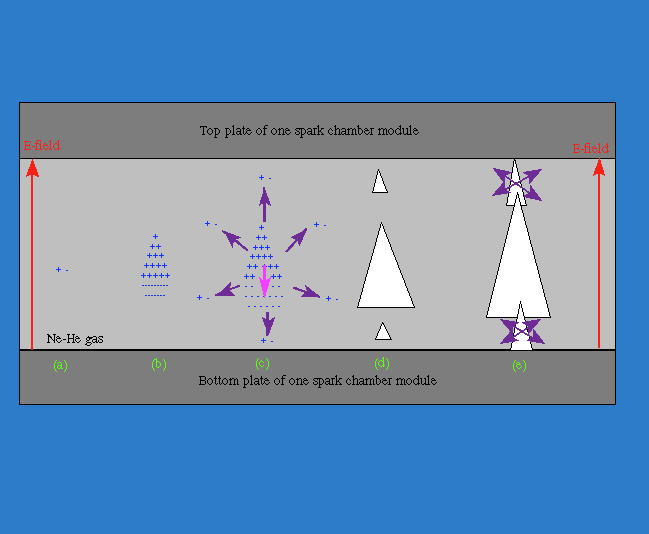
The simple explanation to this question is given in Stage 3 of 'How the Spark Chamber works'. When a cosmic ray has traversed the detector a large potential difference exists across each module. This is a very unstable situation, of which the modules cannot stay like it for any length of time. The plates must discharge.
This discharge will occur along the easiest path possible. The easiest path is through the ionised track left behind in the Ne-He by the passage of a cosmic ray. Therefore the plates will discharge down the ionised track of the cosmic ray, and hence the characteristic spark is observed, and the 'crack' from the discharge is heard.
This explanation is fine, but rather glosses over the details of how a spark actually forms down the
ionised track, a fuller explanation is now given. 
Figure 1: Stages of spark formation within 1 module of the spark chamber
(adapted from Rice-Evans, 1974)
A large potential difference across the closely spaced parallel plates of each module has associated with it an electric field in the vicinity of the plates (as shown in figure 1). An electron (figure 1a) present in the active region of each module (created from the ionisation of the gas mixture as a charged particle traversed the chamber) is accelerated towards the anode plate.
As the electron traverses the active region its energy increases which becomes sufficient to cause ionisation when it collides with a gas molecule in its path. An additional electron is liberated which, after acceleration will also be able to ionise. This process continues and results in the formation of an avalanche, which rapidly builds up. Electrons move towards the 'head' of the avalanche, whilst ions move in the opposite direction (figure 1b).
When the number of electrons in the head approaches 106, the avalanche begins to slow down due to the attraction of the positive ions. When 108 electrons in the head is reached, an electric field within the avalanche is created, which is in the opposite sense to the electric field between the plates (shown in pink in figure 1c). Recombination of electrons and ions results within the avalanche, and photons are emitted isotropically from the avalanche. The emitted photons cause ionisation of surrounding molecules in the vicinity of the original avalanche. The field in front and behind the original avalanche is enhanced, whilst the field around the sides are suppressed. Thus ahead and behind of the original avalanche, new avalanches rapidly form (figure 1d) until the old and new avalanches merge, forming a streamer (figure 1e). The extremities of the streamer grow (in approximately 10ns) until they arrive at the plates. Thus the two plates of each module are connected by a low resistance conducting plasma of electrons and positive ions, which extends in a parallel direction to the electric field lines. A spark subsequently passes between the two plates.
Return to the home page